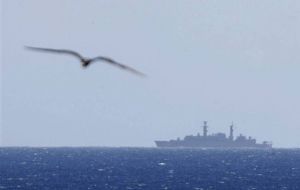MercoPress. South Atlantic News Agency
Flight 447: Airbus 330 faulty speed sensors controversy erupts
 Brazilean Navy found first bodies on Saturday morning
Brazilean Navy found first bodies on Saturday morning Brazilian search crews on Saturday retrieved the first bodies from the crashed Air France flight 447 in the Atlantic, and investigators said faulty speed readings had been found on the same type of jets.
Navy ships found the bodies of two men and debris including a blue seat with a serial number matching Flight 447, a rucksack containing a vaccination card, and a briefcase with an Air France ticket inside, rescue officials said.
“This morning at 8:14 a.m., we confirmed the rescue from the water of pieces and bodies that belonged to the Air France flight,” Air Force spokesman Jorge Amaral told reporters in the northeastern Brazilian city of Recife.
Brazilian Air Force planes and Navy ships have been scouring a swathe of the Atlantic about 1,100 km northeast of Brazil's coast since the Airbus A330-200 plane disappeared on Monday, killing all 228 people on board.
The crash of the flight from Rio de Janeiro to Paris was the world's deadliest air disaster since 2001 and the worst in Air France's 75-year history.
Rescuers, who said that only family members will be informed of the identity of the corpses, believe many bodies could have sunk or been devoured by sharks.
French investigators trying to establish the cause of the crash said on Saturday that Airbus had detected faulty speed readings on its A330 jets before last week and had recommended that clients replace a sensor.
Air France later issued a statement saying it had begun changing airspeed sensors on Airbus long-haul aircraft due to icing fears five weeks before the crash, but only after failing to agree on a fix with Airbus.
Investigators are considering the possibility that the speed sensors on Flight 447 may have iced up, resulting in faulty readings that caused the pilots to set the plane at a dangerous speed as it passed thunderstorms.
But the head of France's air accident agency (BEA) said in a news conference in France that it was too soon to say if problems with the pressure-based speed sensors were in any way responsible for the disaster.
”Some of the sensors (on the A330) were earmarked to be changed ... but that does not mean that without these replacement parts, the (Air France) plane would have been defective” BEA chief Paul-Louis Arslanian said.
Airbus confirmed it issued a bulletin asking the plane's 50 or so airline operators to consider changing the speed sensors, known as Pitot tubes, but it said it was an optional measure to improve performance and not related to safety.
In its statement on Saturday, Air France said it began noticing airspeed problems from icing on both A330 and A340 planes in May 2008 and had requested a solution from Airbus.
According to Air France, Airbus proposed testing different sensors despite earlier doubting that they would resolve the problem, but the airline declined to wait and started changing them from April 27.
The doomed Air France plane sent 24 automated messages in a span of four minutes indicating a series of system failures before it vanished, Arslanian said.
In the middle of this stream of data was one message showing inconsistent speed readings from the A330's sensors, investigators said.
The messages also showed that the autopilot was off, though it was impossible to say whether it had disengaged itself, as it is designed to do when it receives suspect data, or whether the pilot had decided to turn it off, Arslanian said.
Meteorological experts said the jet crossed a storm zone but that the weather did not seem to pose a particular threat.
Investigators have said they are not optimistic that they will be able to locate the plane's flight recorders, which could provide vital information about the cause of the crash.




Top Comments
Disclaimer & comment rulesCommenting for this story is now closed.
If you have a Facebook account, become a fan and comment on our Facebook Page!